
Kayaker gains respect for bay’s beauty
HOMESTEAD, Fla. — I pulled into the small parking lot at the Dante Fascell Visitor Center on a sunny afternoon here and the first thought I had was that I had to be lost.
It seemed, for lack of better phrasing, to be in the middle of nowhere. It didn’t look like the inlet to a massive national park. The closest large facility to the Visitor Center that I passed on the way was the Homestead-Miami Speedway (which hosts the Homestead 500 each year), and it is several miles to the west.
| At right, the view from the entrance to a mangrove channel at Biscayne National Park (Photos by Rob Pursell). Next, the view from inside the mangrove channel at Biscayne National Park. | 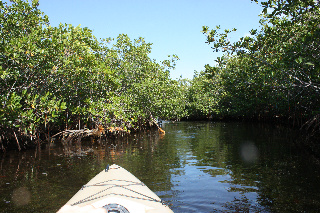 |
While I’m sure watching NASCAR can be exhilarating, I had come to report on the kayaking available in Biscayne National Park, not on the finer points of driving cars 200 miles an hour in circles.
It wasn’t until I had started to walk up the ramp to the visitor center building, that Biscayne revealed it’s natural beauty to me. The bay, which was shimmering in the midday sun, stretched out endlessly before me in a delicate spread of bright turquoise deep cobalt hues. It was interspersed with the pristine white hulls of sailboats docked in the marina outside the visitor center.
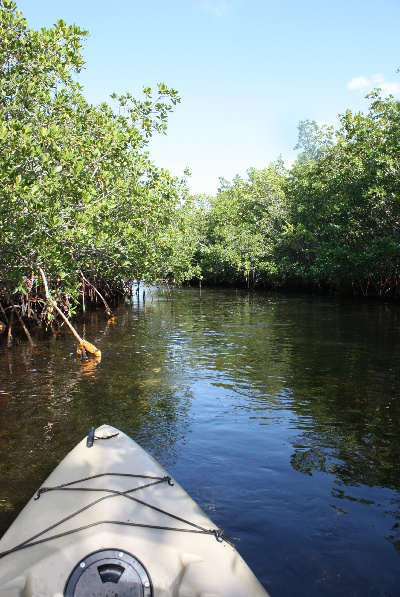 Beyond the sailboats stretched the pristine Florida coastline made up of coral rocks and mangrove trees that play home to various species of bird and fish, creating a green and white-specked horizon that reached out into the Florida waters.
Beyond the sailboats stretched the pristine Florida coastline made up of coral rocks and mangrove trees that play home to various species of bird and fish, creating a green and white-specked horizon that reached out into the Florida waters.
“That’s the real attraction of Biscayne National Park,” said Darlene Kramer, a volunteer who works at the visitor center, “It’s such a naturally beautiful place. It plays host to so many beautiful species of wildlife and fauna, and we can only see the tip of the iceberg looking out over the bay.”
Biscayne National Park was originally a national monument established by President Lyndon B. Johnson in 1968. It later became a national park through legislation in 1980.
It stretches more than 170,000 acres in sunny South Florida and plays home to multiple endangered species such as the West Indian Manatee, the Peregrine Falcon, the American Crocodile, and various sea turtles. It also is home to some of the most beautiful coral reef formations in the world, and dense mangrove forests.
“That’s what most people don’t understand,” said Theresa Borrero, who rents out kayaks and runs snorkel tours out of the Visitor Center store.
“The true beauty of Biscayne lies underneath the surface. A total of 95 percent of the park lies underwater, we have the largest marine ecosystem of any national park in America, and play host to the third largest coral reef in the world. To really understand its beauty, you need to get out into the water.”
Armed with this knowledge, I forked over $16 to rent a sea kayak for the day, dragged my neon yellow vessel past the families having picnics on the lawns of the Fascell Visitor Center, and set off into the crystal waters of Biscayne Bay.
The first thing that I noticed when kayaking through the bay, is how incredibly shallow the water is on the paddle out. In fact, shallow may be an understatement; the water never raises much above ankle level.
But this shallow water offers an immaculate view of the coral rock and sea grass that seem to glow in the Floridian sun. Tiny minnows and glistening fish dart in and out of the green sea grass with each stroke of the kayak paddle.
As I continued my journey out into the bay, I stayed close to the shoreline as it snaked out away from the visitor center. Swallows perch on the white stalks of overhanging mangroves, allowing kayakers to get just close enough to get a good view of their striking features before flapping away.
Before long, I saw a small inlet into the dense thickets of mangroves that make up the shoreline and cut into it. Upon entering, I was greeted with a labyrinth of lush emerald vegetation that rose just past my sightline on each side.
| At right, the rock outcroppings that are home to many species of bird at Biscayne National Park. | 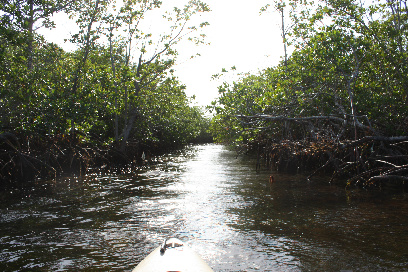 |
The bright sun was only broken by the passing shadow of the circling falcons and for a moment, sitting in the silence of the mangrove maze, time seemed to slow. Paddling back out into the bay, I came upon two rock outcroppings draped in brown pelicans, white ibis, blue-crowned herons and cream-colored coral rocks. Immediately after passing the two rock outcroppings, the shallow sea floor drops off into a sea of deep turquoise.
These warm waters play home to scores of lazy manatees that sunbathe and often float up next to kayakers, and flocks of pelicans that dive into the blue waters to find food.
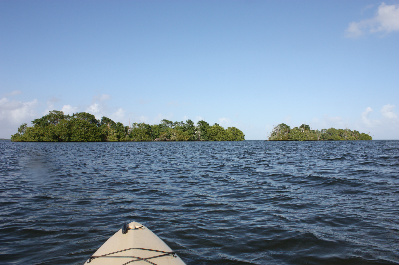 |
At left, the open bay near the Dante Fascell Visitor Center at Biscayne National Park. Below left, a brown pelican in flight over the water at Biscayne National Park. | |
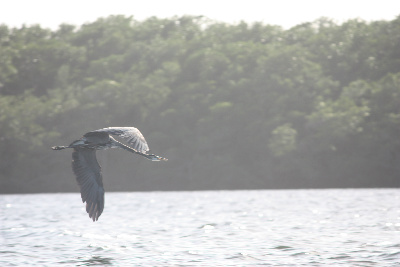 |
Upon entering the deeper water, my kayak began to bob with the flow of the ocean water and I allowed my plastic vessel to float weightlessly in the water as I looked out over the bay.
The sun had begun to set behind the mangroves, casting a golden dust over the clear waters of the bay. I paddled back, pulled my kayak onto shore, and began to drive away from the Fascell Visitor Center.
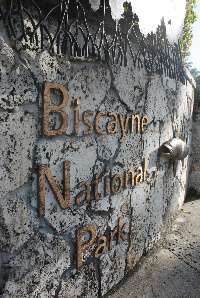 The day which had started out with me doubting whether or not I had come to the right place, had ended in a spectacular fashion, and instilled in me an immense respect for the natural beauty of Biscayne National Park.
The day which had started out with me doubting whether or not I had come to the right place, had ended in a spectacular fashion, and instilled in me an immense respect for the natural beauty of Biscayne National Park.
If You Go
- The Dante Fascell Visitor Center is located at 9700 SW 328th St. in Homestead, Fla. 33033
- Parking and admission at the park are free.
- The easiest way to drive to the park is to take the Speedway exit (exit 6) off of State Route 821.
- The Dante Fascell Visitor Center is open everyday from 9 a.m. to 5 p.m..
- Kayaks are available for rental within the visitor center for $16, and rentals are available each day until 3:30 p.m.

Comments are Closed